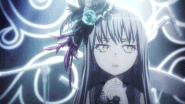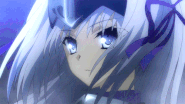"Kuudere" (JP) is a term for a character who appears calm and unemotional most of the time, but becomes cute and loving around their love interest. They don't talk much and have a cold uninterested attitude towards people who are not their love interest. Although it might not appear like it at first, they are hiding a deep inner love inside that will start to come out after becoming closer to their love interest.[1][2][3][4][5][6][7]
Meaning of the Name
Kuudere (クーデレ) is a combination of the English word "cool" which is spelled as "kuuru" (クール) in Japanese, meaning "calm and unemotional", and "deredere" (デレデレ), meaning "to be lovestruck".
They are the type that doesn't show emotions and stays calm and unemotional (cool) no matter what.
Alternate Romanization
Kuudere can also be written as kūdere since the long "u" sound in Japanese can be romanized as either "uu" or "ū".
It is also sometimes unofficially translated as coodere using the English spelling of the word "cool" instead of the Japanese spelling "kuuru".[8]
Characteristics
Moe Factor
The moe appeal of kuudere comes from the large gap between the cool unemotional "kuu" side and the cute loving "dere". The idea of a character who appears cold and completely emotionless that is actually cute and loving gives off strong amounts of adoration towards that character. This is especially true for kuudere who simply have a hard time expressing their emotions. The moment when they finally realize their true feelings of affection can bring strong amounts of satisfaction to the audience like they watched them grow as a person and feel happy for them for finally making it to that point.
Personality
Kuudere are characters who are cool and unemotional most of the time, but are sweet and loving towards their love interest. They may seem emotionless and stoic on the outside, but on the inside they're very passionate and caring, at least when it comes to their love interest.
Kuudere are those characters that look expressionless, won't react to whatever the love interest says, doesn't get jokes, and are most likely regarded as some sort of genius of high IQ. These characters are usually designed with hair colors of white, blue, or other cold colors.
The point of kuudere is that though they're introduced as something like moving ice statues. As they develop their relationship for the other person, they start opening up and even showing expressions like smiling slightly over time.
In some cases, a kuudere will completely melt or break their ice armor, start crying or screaming "I love you". This is when a kuudere goes from "kuu" mode to "dere" mode. It's one of the possible developments when you have a kuudere archetype.
Allegorically speaking, a kuudere is like snow: it may be cold and harsh at first glance, but it is also what keeps autumn's seeds warm and safe until spring. Similarly, while perhaps appearing apathetic and awfully pragmatic, it is but a frosty exterior that protects their tender, delicate feelings deep underneath, waiting for someone to melt the snow and allow them to blossom.
Kuudere characters often speak in a calm monotone and seem unaffected by the world around them. They never seem to be very happy, excited, or surprised, just as they never appear sad, annoyed, or angry as well. Extreme examples may even seem to be completely emotionless like robots. It is used to describe characters who always remain calm and composed. Though they act serious on the outside, they often have a very good, sarcastic sense of humor.
They tend to deeply care and love someone and they have a good personality when you know them, but are afraid to show it too often, because they view it as a weakness. It is either because of who they are, or because of the situation they are in. More often than not, they come off as emotionless, acting very cold and blunt.
Despite disliking to be in charge of a group, they also tend to be leaders who are always in charge of a situation due to their calm, clear-headed and respectable attitude, even in tricky situations. Kuudere characters can be the class presidents that keep their schools running. Other times they take the form of stoic, professional assistants to superiors that they love and respect.
While a kuudere remains uninterested and unsympathetic, they are emotional or empathetic underneath their self-control. However, they tend to fear showing any weakness, such as admitting to liking someone or coming to rely on someone emotionally as well as professionally. Some are unclear as to how to even express their emotions, and, in extreme cases, are unsure what feelings actually mean.
Alternatively, some kuudere characters have some form of neurological disability that affects their ability to communicate, which makes them respond in a robotic-like voice to others, makes them unable to pick up social cues, and makes them only interested in their restricted hobbies, preventing themselves from maintaining true friendships.
Types of Kuudere
Common Types:
Type 1 — Always In Control: Comes off as "kuu-" (cool) because of emotional control, maintaining a calm, collected exterior. Expressions are subtle, with watery eyes being akin to bawling, and a small smile being akin to a giggle fit. Feelings may be filtered through snark or dry wit. The appeal is their bluntness and directness, in contrast to shy reserve or boisterous rowdiness.[citation needed]
If playing a Love Interest, either the other partner will be the source of "Will They or Won't They?", or they'll skip that and the focus will be on the drama that comes after they admit "They Do". Occasionally this is a trait of a more exaggerated character, the "Emotionless Girl/Boy".
Type 2 — Once You Get To Know Them: They will show the 'dere' side, but strangers and those who they don't trust will see the 'kuu' side. Friends all consider them to be caring. In private moments with them, you may just catch them laughing. Although it will still be considered unusual.[citation needed]
It's not that they spare friends any of the "Deadpan Snarker" wit or that they don't act 'kuu' with them sometimes. The friends just understand it better than those that aren't close.
Type 3 — Mood-Swinger: Alternating between 'kuu-' and 'dere' persona depending on mood. What controls the mood? Some may have clearly defined "Berserk Buttons". Companions might learn how to manipulate this to their advantage. Others might switch moods at what seems to be random moments, which can be very unnerving or confusing to those nearby.[citation needed]
Some might contend that this version isn't 'kuu-' (cool) enough to qualify as a kuudere, and might place them in some other category.
Obviously these variations aren't always used pure, and often are mixed together in different characters. Using Raven from Teen Titans as an example, while she fits the first variation best, she certainly has elements of the other two.
Differences From Other Archetypes
The difference between a kuudere and a dandere is that dandere characters don't talk with people due to their shyness, while kuudere characters chose willingly to not talk, only doing so when necessary and even then they will speak with perfect tranquillity. The dandere archetype is nervous and embarrassed with others, contrary to kuudere, who doesn't show emotions and can control their feelings. Furthermore, both of these dere types distance themselves from others for different reasons, making them mostly lack true friendships with others as a hermit or a hikikomori in society. A dandere character feels very sensitive to criticism from others and they feel inferior, even if they desire true friendships or romance with others. A kuudere character thinks that there is nothing wrong with not having any relationships with others and they rather be completely alone.
The darudere type might share some similarities with a kuudere, due to both being distant and uncaring to what others have to say to them, however, a darudere will be more on the bored side than the uncaring side, as they will help out others when really necessary.
The utsudere type is often compared similarly to kuudere, due to them being calm and cool to others. On the contrary, utsudere characters show more emotions of being miserable and hurt. A kuudere will just want to be left alone, as a lone wolf, in peace without any drama occurring in their lives. The difference between a kuudere and a hinedere is that kuudere characters don't care about some things, making them look expressionless in a lot of situations, while hinedere characters show a similar expression due to annoyance, being hateful or feeling cocky. Hinedere characters will snap easily at people if they begin to irritate them, while a kuudere will remain calm and will not care at all.
They can also be mistaken with tsundere, due to how a kuudere can sometimes reply to others without thinking about how the other person would feel, mainly tsundora characters. The difference is how a kuudere will respond to everything unemotionally and may insult nonchalantly without realizing how this can hurt other people, while a tsundere will be more aggressive and start insulting because they feel embarrassed, sometimes knowing very well that this can hurt others.
Similar Japanese Archetypes
- Kidere: A term for a kuudere character who possess ice powers. This is an unofficial Western variation of kuudere.
- Megane: A term for a stoic and intelligent male character who wears glasses.
- Rindere: A term for a female character with a cool reserved exterior who is mature and dignified.
- Tsundora: A term for a character who acts so icy towards their love interest that they make it seem like they seriously hate them.
Characters with this Personality
See Kuudere/Anime Characters to see characters from anime media.
See Kuudere/Western Characters to see characters from western media.
Gallery
References
| Dere Types | |||
|---|---|---|---|
| Japanese | Standard |
Bakadere ♥ Biridere ♥ Bokodere ♥ Butsudere ♥ Darudere ♥ Deredere ♥ Dorodere ♥ Erodere ♥ Gandere ♥ Goudere ♥ Gundere ♥ Himedere ♥ Hinedere ♥ Kamidere ♥ Kichidere ♥ Kiredere ♥ Kiridere ♥ Kuudere ♥ M Dere ♥ Nyandere ♥ Onidere ♥ Ojoudere ♥ Rindere ♥ Roshidere ♥ S Dere ♥ Shindere ♥ Teredere ♥ Tsundere ♥ Undere ♥ Usodere ♥ Utsudere ♥ Uzadere ♥ Wandere ♥ Yandere ♥ Yoidere ♥ Zondere ♥ | |
| Variations |
Deretsun ♥ Tsun-Aho ♥ Tsundora ♥ Tsun-Pure ♥ Tsunshun ♥ Tsuntere ♥ | ||
| Western | Standard |
Bocchandere ♥ Byoukidere ♥ Dandere ♥ Kanedere ♥ Kekkondere ♥ Nemuidere ♥ Oujidere ♥ Smugdere ♥ Teasedere ♥ Thugdere ♥ | |
| Variations |
Ahodere (Western) ♥ Kidere ♥ Mayadere (Western) ♥ Megadere (Western) ♥ | ||
| Other | |||







